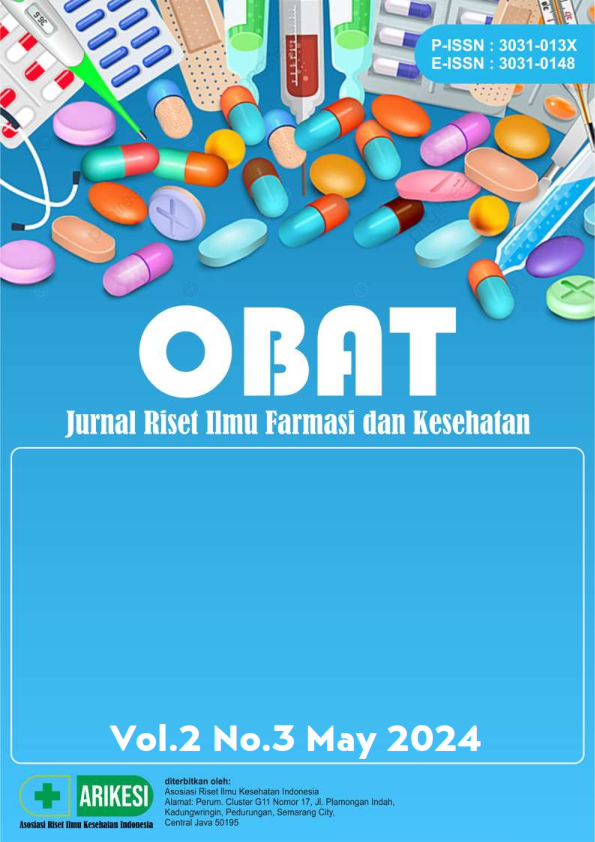Uji Efektivitas Antiinflamasi Sediaan Krim Kombinasi Ekstrak Rimpang Kencur (Kaempferia galanga L.) Dan Daun Srikaya (Annona squamosa L.) Pada Tikus Yang Diinduksi Karagenin
DOI:
https://doi.org/10.61132/obat.v2i3.361Keywords:
Kaempferia galanga L, Annona squamosa L, Anti-InflammatoryAbstract
Inflammation is the body's response when it experiences injury, infection, antigen or cell damage, so it is a sign of something that is harmful to the body or disease. Galangal rhizomes (Kaempferia galanga L.) and Srikaya leaves (Annona squamosa L.) are plants that contain flavonoid compounds which have anti-inflammatory potential by inhibiting the enzymes cyclooxygenase and lipooxygenase. The aim of this research was to determine the effectiveness of a combination cream preparation of galangal rhizome extract and srikaya leaf extract as an anti-inflammatory. The various combinations used are a combination of 15 grams of kecur rhizome extract and 10 grams of srikaya leaf extract, 12.5 grams of srikaya rhizome extract and 12.5 grams of srikaya leaf extract, 10 grams of srikaya rhizome extract and 15 grams of srikaya leaf extract. The anti-inflammatory test uses 1% carrageenin induction of 0.1 ml, then the swelling that occurs is measured using a plastinometer. Based on the results obtained, a good anti-inflammatory power value was a combination of 15 grams of kencur rhizome extract with 10 grams of srikaya leaf extract with a value of 21.6216%. The results of the One Way Annova analysis obtained a p-value >0.05, which means there is no significant difference. So it can be concluded that various combinations of galangal rhizome extract and srikaya leaves are effective in mice induced by carrageenin. A post hoc Tuckey test was carried out on the AUC value, obtaining a p-value >0.05, so it can be concluded that there was no significant difference in the positive controls for formulas 1, 2 and 3.
Downloads
References
Dewi, R. S., Pratiwi, E., & Muharni, S. (2019). Penggunaan Obat Tradisional Oleh Masyarakat Di Kelurahan Tuah Karya Kota Pekanbaru. 8(September).
Fahmi, N., Herdiana, I., & Rubiyanti, R. (2020). Pengaruh Metode Pengeringan Terhadap Mutu Simplisia Daun Pulutan (Urena lobata L.). Media Informasi, 15(2), 165–169. https://doi.org/10.37160/bmi.v15i2.433
Fauzia, R. R., Wangi, S. P., & Sulastri, I. (2017). Uji Efektivitas Anti Inflamasi Salep Ekstrak Rimpang Kencur (Kaempferia galanga L) Terhadap Luka Sayat Pada Tikus Jantan. Pharma Xplore : Jurnal Ilmiah Farmasi, 2(1), 104–114. https://doi.org/10.36805/farmasi.v2i1.121
Iin Lidia Putama Mursal, Anggun Hari Kusumawati, D. H. P. (2019). PENGARUH VARIASI KONSENTRASI GELLING AGENT CARBOPOL 940 TERHADAP SIFAT FISIK SEDIAAN GEL HAND SANITIZER MINYAK ATSIRI DAUN KEMANGI (Ocimum Sanctum L.). Prodi Farmasi Fakultas Teknologi Dan Ilmu Komputer Universitas Buana Perjuangan, 268–277.
Maulina, L., & Sugihartini, N. (2015). FORMULASI GEL EKSTRAK ETANOL KULIT BUAH MANGGIS (Garcinia mangostana L.) DENGAN VARIASI GELLING AGENT SEBAGAI SEDIAAN LUKA BAKAR. Pharmaciana, 5(1), 43–52. https://doi.org/10.12928/pharmaciana.v5i1.2285
Nurcholis, I. A., Yusriadi, & Sulastri, E. (2018). Aktivitas Antiinflamasi Gel Ekstrak Rumput Mutiara ( Ordelandia corymbosa L .) pada Tikus ( Rattus norvegicus L .) yang Diinduksikan Karagenan. Biocelebes, 12(2013), 88–97.
Octasari, P. M., & Ayuningtyas, F. (2016). Anti-inflammatory Effect of cream and ointment from 2,5- bis- (4-Nitrobenzilidine) cyclopentanoneagainst Edema in Mice Induced by Formalin. JPSCR : Journal of Pharmaceutical Science and Clinical Research, 1(2), 102. https://doi.org/10.20961/jpscr.v1i2.1942
Putri Rahwawida, Riki Hardiansah, J. S. (2020). FORMULASI DAN EVALUASI FISIK SALEP ANTI JERAWAT EKSTRAK ETANOL 96% DAUN PEPAYA (Carica papaya L.) TERHADAP BAKTERI Propionibacterium acnes. VII(2).
Setyopuspito Pramitaningastuti, A. (2017). Uji Efektivitas Antiinflamasi Ekstrak Etanol Daun Srikaya (Annona Squamosa. L) Terhadap Edema Kaki Tikus Putih Jantan Galur Wistar. Jurnal Ilmiah Farmasi, 13(1), 8–14. https://doi.org/10.20885/jif.vol13.iss1.art2
Silalahi, M. (2019). Kencur (Kaempferia galanga) dan Bioaktivitasnya. Jurnal Pendidikan Informatika Dan Sains, 8(1), 127. https://doi.org/10.31571/saintek.v8i1.1178
Sugihartini, N., Jannah, S., & Yuwono, T. (2020). Formulasi Gel Ekstrak Daun Kelor (Moringa oleifera Lamk) Sebagai Sediaan Antiinflamasi. Pharmaceutical Sciences and Research, 7(1), 9–16. https://doi.org/10.7454/psr.v7i1.1065
Valkhoff, V. E., Schade, R., Jong, G. W., Romio, S., Schuemie, M. J., Arfe, A., Garbe, E., Herings, R., Lucchi, S., Picelli, G., Schink, T., Straatman, H., & Villa, M. (2013). Population-based analysis of non-steroidal anti-inflammatory drug use among children in four European countries in the SOS project : what size of data platforms and which study designs do we need to assess safety issues ?
Wahyuddin, M., Kurniati, A., & Aridewi, G. A. P. (2018). Pengaruh Konsentrasi Carbopol 940 Terhadap Stabilitas Fisik Sediaan Masker Ekstrak Buah Mengkudu (Morinda citrifolia L.) Sebagai Anti Jerawat. Jf Fik Uinam, 6(1), 25–33.
Downloads
Published
How to Cite
Issue
Section
License
Copyright (c) 2024 OBAT: Jurnal Riset Ilmu Farmasi dan Kesehatan

This work is licensed under a Creative Commons Attribution-ShareAlike 4.0 International License.





